![]()
![]()
![]()
Use LEFT and RIGHT arrow keys to navigate between flashcards;
Use UP and DOWN arrow keys to flip the card;
H to show hint;
A reads text to speech;
70 Cards in this Set
- Front
- Back
- 3rd side (hint)
|
Organization |
Social unit composed of 2 or more people working towards a common set of goals |
|
|
|
Behavior |
The way one conducts oneself, especially towards others |
|
|
|
Management Roles |
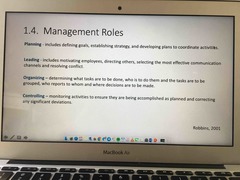
Planning, Leading, Organizing, Controlling |
|
|
|
Contributing Fields to OB (5) |
Sociology, Anthropology, Social Psychology, Political Science, Psychology |
|
|
|
Personal Characteristics (4) |
Age, Gender, Marital Status, Tenure |
|
|
|
Ability |
An individuals capacity to perform the various tasks in a job |
|
|
|
Types of Ability (2) |
Physical ability, intellectual ability |
|
|
|
Foundations of Organizational Behavior (3) |
Personal Characteristics, Ability, Learning |
|
|
|
Types of Learning |
Classical Conditioning Operant conditioning Social Learning |
|
|
|
Values |
Basic convictions that specific mode of conduct is personally or socially preferable to an opposite mode of conduct |
|
|
|
Values |
Basic convictions that specific mode of conduct is personally or socially preferable to an opposite mode of conduct |
|
|
|
Value system |
Hierarchy based on ranking of an individual’s values in terms of their intensity |
|
|
|
Cultural Dimensions Theory by Hofstede (6) |
Power distance (high or low) Individualism vs. Collectivism Uncertainty Avoidance (high or low) Masculinity vs. Femininity Long term vs. Short term Indulgence vs. Self restraint |
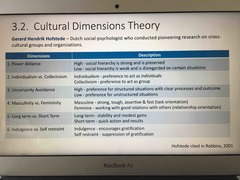
|
|
|
Attitudes |
Evaluative statements of judgements concerning objects |
|
|
|
Components of Attitude (3) |
Cognitive component Affective component Behavioral component |
|
|
|
Personality |
The sum total ways in which an individual reacts and interacts with others |
|
|
|
Personality Determinants (3) |
Heredity Environment Situation |
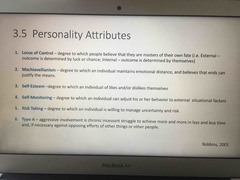
|
|
|
Personality Attributes (6) |
Locus of control Machiavellianism Self-esteem Self-monitoring Risk taking Type A |
|
|
|
Myers Briggs Type Indicator |
A personality test that taps four characteristics and classifies people into 16 personality types |
|
|
|
Types of emotions (6) |
Emotions Affect Mood Felt emotions Displayed emotions Emotional labor |
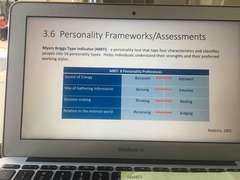
|
|
|
Dimension of emotions (4) |
Variety Intensity Frequency Duration |
|
|
|
6 universal Emotions |
Happiness Surprise Fear Sadness Anger Disgust |
|
|
|
Emotional intelligence |
Assortment of non-cognitive skills, capabilities, and competencies that influence a persons ability to succeed in coping with environmental demands and pressures |
|
|
|
5 dimensions of Emotional Intelligence |
Self awareness Self management Self motivation Empathy Social skills |
|
|
|
Job Fit |
Extent to which an individual’s ability matches the requirements of the job |
|
|
|
Motivation |
Process that accounts for an individual’s intensity, direction, and persistence of effort toward attaining a goal |
|
|
|
6 Motivation theories |
Maslow’s hierarchy of needs Theory X and Y Two factor (motivation-hygiene) theory McClelland’s Theory of needs Goal setting theory Reinforcement theory |
|
|
|
Maslow’s hierarchy of Needs |
Motivation theory developed by Abraham Maslow where he explains that every human being exists a hierarchy of needs |
|
|
|
Maslow’s hierarchy of Needs |
Motivation theory developed by Abraham Maslow where he explains that every human being exists a hierarchy of needs |
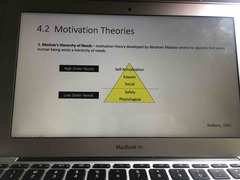
|
|
|
The 5 needs according to Maslow’s hierarchy |
Physiological Safety Social Esteem Self-actualization |
|
|
|
Theory X and Y |
Theory developed by Douglas McGregor that suggests two views on individuals |
|
|
|
Theory X and Y |
Theory developed by Douglas McGregor that suggests two views on individuals |
|
|
|
Theory X |
Type under motivation theory X and Y wherein employees dislike work, lazy, dislike responsibility and needs to be coerced |
|
|
|
Theory Y |
Type of motivational Theory X and Y wherein employees like work, creative, seek responsibility, and can exercise self-direction |
|
|
|
Two factor (Motivation-hygiene) theory |
Henry proposed by Fredrick Hazerberg that suggests two views on individuals |
|
|
|
Two views of the two factor Theory by Harzberg |
Hygiene (extrinsic) - factors that when adequate in a job prevent dissatisfaction e.g. company policy Motivators (intrinsic) - factors that when emphasized promotes satisfaction e.g. personal growth |
|
|
|
McClelland’s Theory of Needs |
Motivation theory composed of achievement, power and affiliation |
|
|
|
McClelland’s Theory of Needs |
Motivation theory composed of achievement, power and affiliation |
|
|
|
3 needs according to McClelland |
Achievement (N ach) Power (N pow) Affiliation (N aff) |
|
|
|
Goal setting theory |
Motivation theory wherein specific reasonably difficult goals with feedback lead to high performance |
|
|
|
Goal setting theory |
Motivation theory wherein specific reasonably difficult goals with feedback lead to high performance |
|
|
|
Reinforcement Theory |
Motivation theory that proposes that reinforcement conditions behavior |
|
|
|
Goal setting theory |
Motivation theory wherein specific reasonably difficult goals with feedback lead to high performance |
|
|
|
Reinforcement Theory |
Motivation theory that proposes that reinforcement conditions behavior |
|
|
|
Push and Pull factors |
Refers to a perspective in geography that helps the migration of people |
|
|
|
Goal setting theory |
Motivation theory wherein specific reasonably difficult goals with feedback lead to high performance |
|
|
|
Reinforcement Theory |
Motivation theory that proposes that reinforcement conditions behavior |
|
|
|
Push and Pull factors |
Refers to a perspective in geography that helps the migration of people |
|
|
|
Job Satisfaction |
A general attitude towards ones job, the difference between the amount of rewards workers receive and the amount they believe they should receive |
|
|
|
Perception |
A process by which individuals organize and interpret their sensory impressions in order to give meaning to their environment |
|
|
|
Perception |
A process by which individuals organize and interpret their sensory impressions in order to give meaning to their environment |
|
|
|
Situations affecting perception (3) |
Time Work setting Social setting |
|
|
|
Perception |
A process by which individuals organize and interpret their sensory impressions in order to give meaning to their environment |
|
|
|
Situations affecting perception (3) |
Time Work setting Social setting |
|
|
|
Factors affecting the perceiver (5) |
Attitudes Motives Interests Experience Expectations |
|
|
|
Perception |
A process by which individuals organize and interpret their sensory impressions in order to give meaning to their environment |
|
|
|
Situations affecting perception (3) |
Time Work setting Social setting |
|
|
|
Factors affecting the perceiver (5) is |
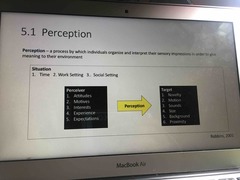
Attitudes Motives Interests Experience Expectations |
|
|
|
Factors affecting a target of perception (6) |
Novelty Motion Sounds Size Background Proximity |
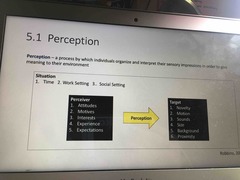
|
|
|
Perception Theories (7) |
Attribution theory Self-serving bias Selective perception Halo Effect Contrasts effects Projection Stereotyping |

|
|
|
Perception Theories (7) |
Attribution theory Self-serving bias Selective perception Halo Effect Contrasts effects Projection Stereotyping |
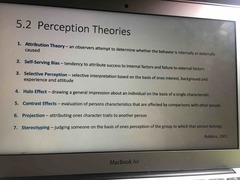
|
|
|
Problem |
Discrepancy between a current state and a desired state |
|
|
|
Perception Theories (7) |
Attribution theory Self-serving bias Selective perception Halo Effect Contrasts effects Projection Stereotyping |
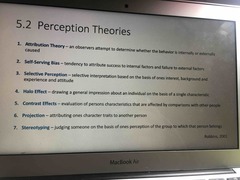
|
|
|
Problem |
Discrepancy between a current state and a desired state |
|
|
|
Decisions |
Choices made from two or more alternatives |
|
|
|
Perception Theories (7) |
Attribution theory Self-serving bias Selective perception Halo Effect Contrasts effects Projection Stereotyping |
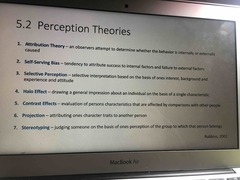
|
|
|
Problem |
Discrepancy between a current state and a desired state |
|
|
|
Decisions |
Choices made from two or more alternatives |
|
|
|
2 decision making approaches |
Intuition Bounded reality |
|
|
|
Rational Decision Making model (6 steps) |
Define the problem Identify the criteria Allocate weights to the criteria Develop alternatives Evaluate alternatives Select the best alternative |
|

